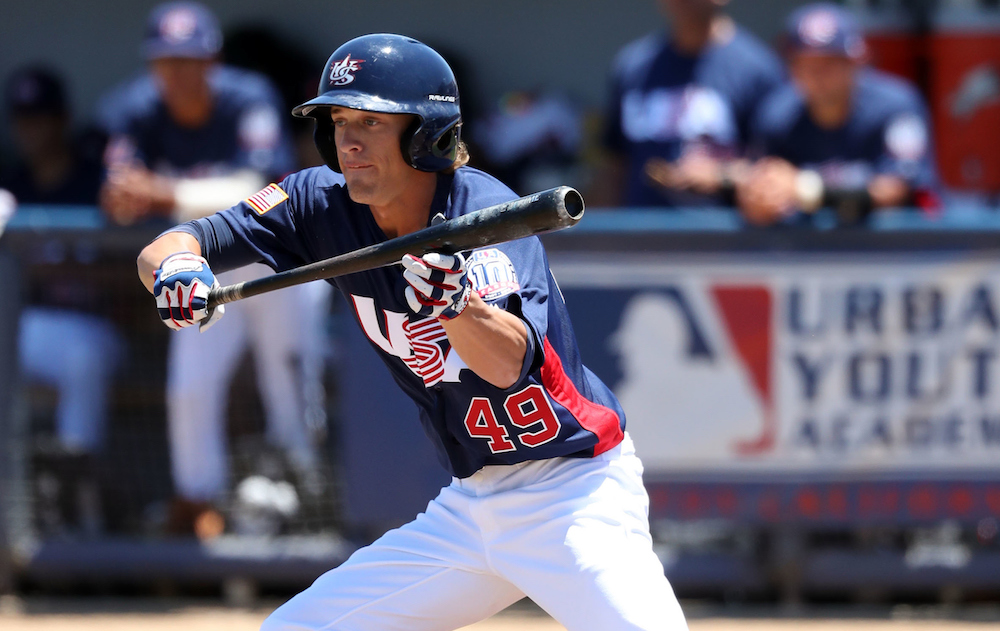Feature Photo: T.J. Friedl, OF, Reds
Reds outfielder T.J. Friedl popped a few eyeballs with a $732,500 signing bonus as an undrafted free agent signing on August 4th, but he didn’t slip by our Dave DeFreitas, who spotlights Friedl after he passed through SoCal with the USA Baseball Collegiate National Team in early July. DeFreitas also profiles on-base machine Jesse Winker (OF, Reds). We’re also welcoming new contributor Billy Henley to the 2080 family in this week’s update, and he took a look at Josh Bell (1B, Pirates) and Rio Ruiz (3B, Braves) after a recent series down at Triple-A Gwinnett. Mark Shreve takes an in-depth look at the recent starts of Yankees 21-year-old RHP Ronald Herrera for the Double-A Trenton Yankees, and Nick J. Faleris checks in with updates on White Sox RHP Zack Burdi, and the Mets’ 2016 first-rounder and hard-throwing righty Justin Dunn, who is off to a great start for Short-Season A Brooklyn in the NY-Penn League.
Triple-A Prospect Spotlights
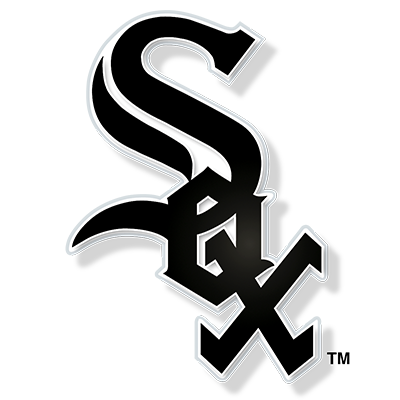 Zack Burdi, RHP, White Sox (Triple-A Charlotte, International League)
Zack Burdi, RHP, White Sox (Triple-A Charlotte, International League)
Ht/Wt: 6’3” / 205 B/T: R/R Age: 21 yrs, 5 m
The hard-throwing righty notched two perfect one-inning outings this past week, including his first at the Triple-A level, extending his no-hit streak to 9.2 innings – his last hit allowed coming back on July 23rd off the bat of Kean Wong (2B, Rays, Double-A Montgomery, Southern League). The former Louisville closer has big league swing-and-miss stuff, averaging almost two strikeouts per inning, and has recently upped his game by limiting base runners, having yet to allow a base runner in the month of August.
Burdi’s fastball can reach triple digits, routinely working in the upper 90s and flashing quality life – particularly down in the zone. His slider is a true plus offering at present, showing impressive bite and depth. He’s improved his command over the pitch in 2016, and is showing a high degree of comfort working it both in and out of the zone. His changeup is a third above-average offering, flashing swing-and-miss dive, and while clearly his tertiary option, it has the potential to emerge as a true weapon with minimal refinement.
Burdi has the making of a dominant late-inning arm thanks to electric stuff and an improving ability to wield that stuff with confidence and authority. It would not be a surprise to see him break camp with the White Sox next spring, and a September call-up seems like a foregone conclusion at this point. If you have a chance to catch him in Charlotte, don’t delay. It doesn’t look like his stay in the Queen City will be a long one. – Nick J. Faleris
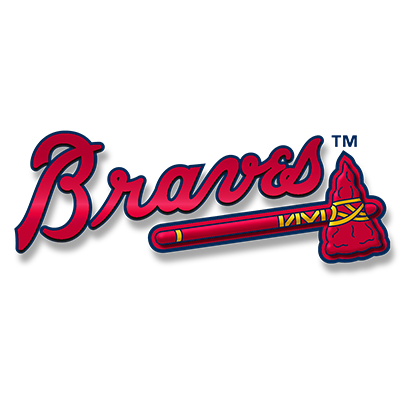 Rio Ruiz, 3B, Braves (Triple-A Gwinnett, International League)
Rio Ruiz, 3B, Braves (Triple-A Gwinnett, International League)
Ht/Wt: 6’1”/230 B/T: L/R Age: 22 yrs, 2m
Ruiz has made a name for himself in the Braves’ organization this year, taking advantage of a promotion to Triple-A Gwinnett despite a somewhat down year in Double-A Mississippi in 2015. MLB’s 15th-ranked prospect in the Braves’ system is currently slashing .269/.351/,374, showing improvement in all three categories from last year’s numbers. Ruiz moves athletically on the field, with fluid actions at third base and a definite feel for playing the position. He showed off his athleticism the night I saw him, making an exceptional play on a ball bunted to the first-base side of the pitcher’s mound. Ruiz beat both the pitcher and catcher to the ball and recording the out.
He hits from a traditional square stance, with a slight hover in his stride. He showed game pop, tomahawking an up-and-in fastball for a home run to right-center field. A contributing factor to his increased offensive output could be his approach at the plate. He has a willingness to take borderline pitches and work deep into counts (50:99 K:BB rate over 439 PAs in in 2016), and an above-average two-strike approach. In eight ABs in this viewing, he got two hits on good two-strike pitches, letting the ball get deep and taking singles to the opposite field.
While Ruiz does not have plus speed, his instincts and effort make up for it. After flaring a single to left field, he took advantage of lazy outfield play to stretch a single into a hustle double. Ruiz is not a player that is going to wow the front office with one specific tool, but he could still do enough to help a big league club on a regular basis. What does stand out is the effort and attitude that he brings to the field. He has the tools and the intangibles to be in the big leagues soon, and has the potential to bring some stability to a position in Atlanta that has been a revolving door for the past few years. – Billy Henley
 Jesse Winker, OF, Reds (Triple-A Louisville, International League)
Jesse Winker, OF, Reds (Triple-A Louisville, International League)
Ht/Wt: 6’3”/215 B/T: L/L Age: 22 yrs, 11m
The Reds’ Compensation Round A pick (#49 overall) in the 2012 MLB Draft, Winker has displayed a unique level of comfort at the plate throughout his brief professional career. In 2013, his first full season as a pro, he was the Reds’ Minor League Hitter of the Year after putting up a .281 AVG, .379 OBP and .841 OPS in the Class A Midwest League. He did not show the swing-and-miss struggles that can afflict young hitters who are just getting their feet wet, but went on to walk 63 times in 483 PAs while only striking out 75 times. Not bad for a kid straight out of high school. In the three years since, Winker has not slowed his on-base onslaught, reaching base at .399 OBP across two levels in 2014 and .390 OBP in 2015, his first full season at Double-A. So far in 2016 he is sitting at a .384 OBP through his first 384 PAs at Triple-A Louisville, while only striking out about 13% of the time.
Winker stays pretty upright in the box and has a short, simple load with a level swing plane, keeping the barrel in the zone for an extended period. He doesn’t have a lot of movement with his hands as the ball is traveling and can be very quick inside. He tends to pull off the outer third of the plate at times, but he has good feel for the barrel and is able to keep his hands back when he’s fooled. He has good power to pull and is a strong kid, but he keeps the ball on the ground (1.45 GO/AO career rate) and the damage potential tends to lean more towards line drives in the gaps rather than home runs. Pre-2016, he was averaging about 13-to-15 HR’s a year, and based on his BP rounds, my guess is that most of those have been to the pull side. He has the pop to drive the ball out to center and left field, but he does not stay on the outer third of the plate as well as he could, with the hips opening early, leaving his hands to generate all the power the other way. His hands are so good however, that he is able to stay on those pitches enough to get enough barrel to them. This weakness out-and-away was exposed some last season when facing the stronger Double-A pitching when he hit .211 vs. lefties with only seven extra base hits (.326 SLG vs. LHP/.423 SLG vs. RHP in 2015). He still saw the ball well however with a 1.4 SO:BB ratio. As he is advancing, it makes sense that pitchers are exploiting this tendency and they’ll continue to do so until he shows that he is able to hit the ball with some authority to the middle of the field.
His power numbers across the board have fallen significantly in 2016, with a .377 SLG over 297 ABs, and with only five extra base hits in 89 ABs vs. lefties. That said, the plus on-base ability has remained, checking in with a .384 OBP to date (includes 15 BBs to 18 Ks vs. LHP); so he is seeing the ball and not expanding the zone.Winker is a strong kid and a good athlete, and he has hand speed and is able to drive the left-center field gap. I don’t think many really saw him as a power prospect from the get go, but if he can adjust and hit the ball middle away with more authority, he should develop into a doubles machine who is tough to strike out.
He should play average defense at a corner-outfield spot, with an average-grade, accurate arm. He is a below-average runner, but he moves well and looked comfortable coming in on a couple balls hit right at him in right field. He looked good going into the corner and showed some range into the right-center field gap as well. Overall, he carries himself like he belongs at the level and I would bet on him to make the necessary adjustments at the plate going forward. He doesn’t have real loud tools, and he may fly under the radar as a major league prospect into 2017, but he can do some things to help a club win at the next level, and could impact the outfield situation in Cincy early next season. -Dave DeFreitas
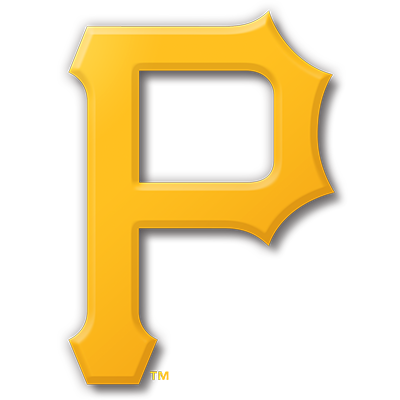 Josh Bell, 1B, Pirates (Triple-A Indianapolis, International League)
Josh Bell, 1B, Pirates (Triple-A Indianapolis, International League)
Ht/Wt: 6’2”/245 B/T: S/R Age: 22 yrs, 11m
Bell is back in Triple-A after a short but successful weekend trip to the big leagues in early July. A second round pick in 2011, Bell is listed as the best power-hitting prospect in the Pirates organization, and the third-ranked prospect in the system according to milb.com. In my short look, he only swung from the left side, where he hits from an open, crouched stance with the bat almost flat on his shoulder. He uses a leg lift with a slight hover at the top, getting his lower half into a strong hitting position. His hand load includes a violent upward motion that gets the bat to almost vertical.
While he gets into a good hitting position, the pre-pitch approach has a lot of moving parts, and the extreme bat head movement may be a cause for slight concern, as he showed some trouble handling good fastballs on the inner half. He showed gap-to-gap power in BP, making loud contact to all parts of the field. For a power hitter, the swing is flat through the zone, and he does not generate much loft, but the ball shows carry to all fields. For the season, he’s slashing .305/.391/.485 for Indianapolis, and showing fairly equal success from the left side of the plate (.316/.396/.502 in 275 ABs) and from the right (.280/.381/.448 in 125 ABs).
While Bell is close to having a major league-ready bat – if it’s not there already – his defense is not yet where it needs to be. He made the transition to first base in 2015 after being drafted as an outfielder. His footwork around the bag is sloppy at times, and he can be tentative when taking a ground ball. In my viewing, he missed a chest-high pickoff attempt that turned into a two-base error. However, if he can get himself to even close to average as a defender, the hit tool and plus pop will have him back at the big league level soon. – Billy Henley
Double A Prospect Spotlight
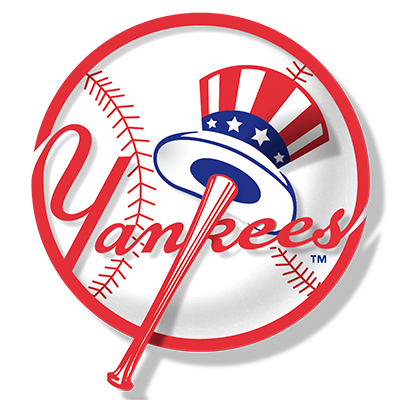 Ronald Hererra, RHP, Yankees (Double-A Trenton, Eastern League)
Ronald Hererra, RHP, Yankees (Double-A Trenton, Eastern League)
Ht/Wt: 5’11 / 185 B/T: R/R Age: 21 yrs, 3m
Herrera’s August 3rd start vs. Hartford was a case study in the early-inning trouble he’s been having since the All-Star break. He struggled to locate his fastball in the first two innings, and at the same time had trouble gripping his breaking stuff, which led to flat offerings being left up in the zone and getting hit hard. He threw 44 pitches in those two innings, giving up 5H, 3R, 2 ER, with each of the 12 ABs ending with contact, and just five first-pitch strikes to the first 12 batters he faced.
He did settle in the second time through the lineup after changing up his sequencing and starting some hitters with the changeup, and a few sliders with men on, which then set up a better-commanded fastball that found some movement. For the remaining 3.1 innings, with improved sequencing of his four-pitch mix for strikes keeping hitters off balance, he allowing just two more hits and no runs, with two walks and a strikeouts.
His delivery was more fidgety than my past viewing, rocking to-and-from the plate at times while receiving his sign with glove at the waist, before toe-tapping a final time to gather, and then leading to a smooth delivery with a moderate leg lift leading to a hard push and solid extension of the rubber, and a quick arm action from a 3/4 slot. There is some drop-and-drive there, but it’s not a pronounced drop, and overall he is able to repeat his mechanics, though he will fall to the first base side at times when dialing up the velocity. Here’s some video of the motion from a separate visit I made to the park on 7/29:
His fastball sat 89-to-93 (T94), and it showed solid two-seam boring action, using it inside and as an effective backdoor to righties. He also flashed a cut version with some sink that was located mostly down and in to lefties that sat in the lower end of the velo band. His changeup sat 82-to-84 mph and was the most effective pitch of the night, and he was able to spot it to the outer third with some arm-side fade to lefties and some tumble to both lefties and righties, and throwing in back-to-back at times. It’s indistinguishable out-of-hand vs. the fastball, which plays it up. His slider (83-to-86) had a flat, cutter shape early on, but by the third inning it was clearly separated from the cut version of the fastball, showing some sharper strike-to-ball sweep with some late bite when it was dialed in. He struggled with the curveball (77-to-81 mph) early, showing gradual break before developing a more typical 11-to-5 shape with average depth and some snap in the higher velo range as the game went on.
Overall, Hererra’s bread-and-butter is commanding his four-pitch mix down in the lower third to get guys out. But his past month’s work shows a pattern of inconsistency in the early frames, with his last three losses looking like this – (6 hits, 5 ER in first two IP vs. Bowie 7/6 (38P); 3 ER, 4H in first two IP vs. Reading 7/14 (48P); 2H, 3R/2ER in 8/8 start vs. Richmond (no-decision), with first 13 ABs ending in contact (32P). That said, he’ll need to focus on mixing his pitches more aggressively early in the game vs. stubbornly trying to establish the fastball, as he did in this 8/3 viewing. And he’ll need to focus on first-pitch strikes and getting ahead in the count more consistently to be more effective (3.02 ERA working ahead, 5.87 when behind), especially early in games and against righties, who are hitting .293 against him (vs. lefties at .226) this season
That said, he is a durable 21-year old with a solid four-pitch mix, and a regular turn in the Trenton rotation shows that the Yankees are confident in his development path at this point, though they would prefer to be seeing more consistency in the quality of his starts to finish the year on a high note. – Mark Shreve
Class A Prospect Spotlight
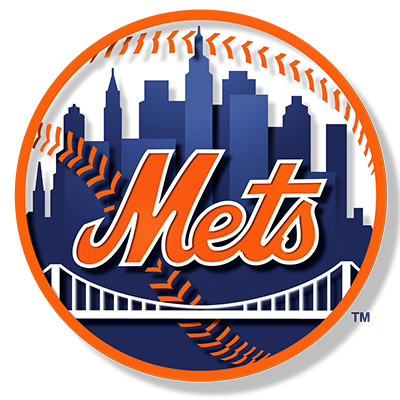 Justin Dunn, RHP, Mets (Short-Season A Brooklyn, New York-Penn League)
Justin Dunn, RHP, Mets (Short-Season A Brooklyn, New York-Penn League)
Ht/Wt: 6’2” / 185 B/T: R/R Age: 20 yrs, 11 m
The 19th-overall selection in this June’s MLB First-Year Player Draft, Dunn has met all expectations through his first 18 innings of work, allowing just one run and 13 hits over that span while striking out 19. After three no-hit innings this past Thursday against Vermont – a start in which the Boston College product struck out two out of every three players he faced – Dunn extended his current scoreless streak to 12 innings.
The hard-throwing righty began his junior season at BC as the Eagles’ closer before converting to the weekend rotation in April, and he never looking back. Capable of kissing the upper 90s in relief, Dunn sat, and continues to sit, comfortably in the 92-to-95 mph velocity band as a starter thanks to a loose arm and motion that affirms his athleticism and quick-twitch actions. He backs up an easy plus heater with two distinct breaking balls – a two-plane upper-70s curveball with solid shape and average bite, and a quality low-80s slider – each of which project as at least average offerings. He rounds out the repertoire with an effective mid-80s changeup that features sharp dive and good deception off of his slot and arm speed.
There’s still a bit of the unknown with Dunn, as the righty is a relatively recent convert to the starting role. Even after a dominant performance over multiple months leading up to the draft, it’s yet to be determined what his stuff looks like 15, 20, and 25 starts into a full season, and his pro outings thus far have been limited to two or three innings an outing. The signs all point to an arm that should be able to handle the load, given his athleticism, ease of action, and quality of his four-pitch mix. He’s still fine-tuning a more paced delivery that debuted last summer on the Cape, which has helped to drastically improve his control over the past twelve months and limit his free passes to hitters. Dunn projects as a quality mid-rotation arm, and perhaps more if he can show an ability to maintain his stuff over the course of a full-season’s schedule. – Nick J. Faleris
Rookie League Prospect Spotlight
 T.J. Friedl, OF, Reds (Rookie Billings, Pioneer League)
T.J. Friedl, OF, Reds (Rookie Billings, Pioneer League)
Ht/Wt: 5’10”/170 B/T: L/L Age: 20 yrs, 11m
Friedl’s well-documented draft (or non-draft) situation likely sparked a few uncomfortable conversations between area scouts and their directors. Friedl, who came seemingly out of nowhere this past year to hit .401 at the University of Nevada, went undrafted in June and signed last month for an unprecedented $732,500, roughly equivalent to third-round bonus money.
Friedl is a plus athlete with the tools to stay in center field. He has a compact frame with squared shoulders and some present strength. He doesn’t have a ton of physical projection, but he is a high-energy kid who gets the most out of his body. His plus run (3.95 & 4.10 HP-to-1B) plays well in the outfield and should make him a threat on the bases going forward in pro ball. In a short look at him during the Team USA games in SoCal last month, he looked extremely comfortable in center, ranging into the gaps and going back on a hard hit ball directly over his head. At the plate he has a relatively compact stroke with average bat speed, but tends to pull off pitches on the outer half, getting some rollover. I don’t see him hitting for a lot of power, but he is strong enough to run into a few to the pull side. Given his tool set, his game is going to be shooting the gaps and using his wheels to pressure the defense and look to take the extra base. He looks confident at the plate and I can see him consistently putting up good AB’s as he advances, however he is going to have to show that he can handle the pitch out away from him with authority in fairly short order to justify the Red’s $1.18 million investment ($732,500 bonus + 75% tax for exceeding the team’s bonus allotment).
He has been all over the bases thus far in Billings, going 12-for-24 with seven extra-base hits and seven runs scored through his first six games. However, the Pioneer League is , at best, similar to the competition he saw in college this past year, as most of those kids are a year or two younger than Friedl. So I’d expect him to be sent to the Instructional League this fall, where he will get a small taste of better stuff he stands to face at the upper levels.
As far as the confusion surrounding Friedl’s draft status, it appears that it was not this huge miss by teams that it is being made out to be. Most scouts whom I spoke with conceded that they knew he was eligible, but thought he would be returning to Nevada, which is understandable since that’s what he told his coaches, and because he would stand to jump to the first round if he replicated his big 2016 season. For a kid like that, even to be taken further down the boards, signability is an issue because he would still command significant money to be bought out of the chance to boost his stock in 2017. So that plus the fact that the kid himself didn’t know he was draft eligible, combined with the overall lack of track record made it a relative perfect storm for scouting departments and saw Friedl slip through the smallest of cracks. I don’t think the Reds were more prepared than everyone else–I think they were simply one of the clubs that recognized the opportunity, had some money left to spend AND had seen enough of the kid to believe that his 2016 success was real. – Dave DeFreitas
New Content at 2080 Baseball
Videos
- Alec Dopp brings us nine new videos from the New York-Penn League taken over the past week, while Dave DeFreitas starts previewing the 2017 MLB Draft class with fresh video from last week’s Area Code Games.

